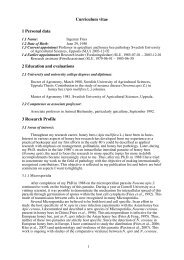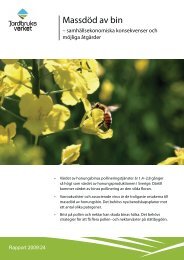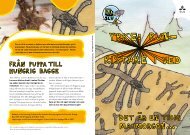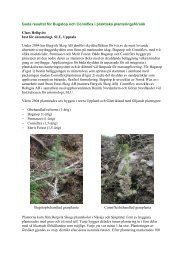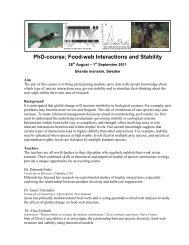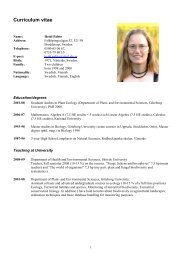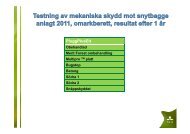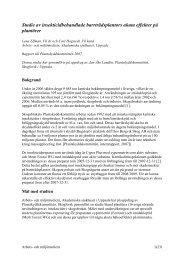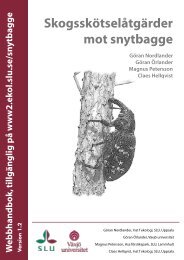Ingemar Ahlén, Lothar Bach, Hans Baagøe, & Jan
Ingemar Ahlén, Lothar Bach, Hans Baagøe, & Jan
Ingemar Ahlén, Lothar Bach, Hans Baagøe, & Jan
You also want an ePaper? Increase the reach of your titles
YUMPU automatically turns print PDFs into web optimized ePapers that Google loves.
Bats and offshore wind turbines<br />
studied in southern Scandinavia<br />
2005 - 2006<br />
<strong>Ingemar</strong> <strong>Ahlén</strong>, <strong>Lothar</strong> <strong>Bach</strong>, <strong>Hans</strong> <strong>Baagøe</strong>, & <strong>Jan</strong> Pettersson<br />
Presented by <strong>Ingemar</strong> <strong>Ahlén</strong><br />
Bats & Wind Energy Cooperative Workshop 8-10 <strong>Jan</strong>. 2008. BCI, Austin, Texas
Bat photo: Björn Söderlund<br />
Bats and offshore wind turbines<br />
studied in southern Scandinavia<br />
2005 - 2006<br />
<strong>Ingemar</strong> <strong>Ahlén</strong>, <strong>Lothar</strong> <strong>Bach</strong>, <strong>Hans</strong> <strong>Baagøe</strong> & <strong>Jan</strong> Pettersson<br />
Swedish Environmental The ’Vindval’ Swedish Energy<br />
Protection Agency program Agency
Project management and persons taking part<br />
<strong>Ingemar</strong> <strong>Ahlén</strong>, Professor, Ph.D., zoologist. Dep. of Ecology, SLU, Uppsala.<br />
Project leader. E-mail: ingemar.ahlen@ekol.slu.se<br />
<strong>Lothar</strong> <strong>Bach</strong>, Dipl.-Biol, zoologist. Bremen. Assistant project leader.<br />
<strong>Hans</strong> J. <strong>Baagøe</strong>, Ph.D, curator, The Natural History Museum of Denmark,<br />
Zoological Museum, Mammal section, University of Copenhagen. Taking part<br />
in the Öresund area 2006.<br />
Tommy Gustafsson, biologist, County administration in Kalmar. Field assistant.<br />
Alexander Eriksson, biologist, County administration in Kalmar. Field assistant.<br />
Petra Burkhardt, biologist, Bremen. Analyses of data from Kalmarsund 2006.<br />
Julia Lopau, biologist, Bremen. Taking part in Kalmarsund 2006.<br />
Dave Karlsson, entomologist, Uppsala university, Ecological research station,<br />
Ölands Skogsby. Sampling insects.<br />
Kajsa Glemhorn, entomologist, Uppsala university, Ecological research station,<br />
Ölands Skogsby. Identification of insects.<br />
Svante Martinsson, entomologist, Uppsala university. Ecological research station,<br />
Ölands Skogsby. Identification of insects.<br />
<strong>Jan</strong> Pettersson, ornitologist. Färjestaden. Radar studies in Kalmarsund.<br />
Lars Pettersson, Senior lecturer, electronics expert. Development of ultrasound<br />
technology for the project.
Norway<br />
Denmark<br />
Germany<br />
Sweden<br />
Öland<br />
Gotland<br />
Baltic Sea<br />
Poland<br />
Finland<br />
Latvia<br />
Estonia<br />
Lithuania
Migrant bat species in Scandinavia have to cross the sea<br />
for hibernation on the European continent.<br />
But 15 years ago we didn’t not know how and where they travelled<br />
. .<br />
From National Atlas of Sweden. Geography of Plants and Animals 1996. Stockholm
Available knowledge at the start of the offshore project:<br />
• Migration of bats studied at the coasts since 1993<br />
• Pilot studies of landbased wind turbines in 2002-2003
On land we discovered flyways leading to certain points.<br />
Bats often followed the coastlines in August and September
We also found flyways along linear elements such as<br />
forest edges and the stone dike on the picture
Points at the southern coasts with concentrated<br />
flyways were found. Bats could easily be observed<br />
and recorded there.<br />
This is Ottenby where most bats leave Öland for the continent
The point where bats leave the island of Gotland in the middle of the Baltic Sea<br />
Distance to Polish or German coast about 250 km!<br />
Hoburgen, the southern point of Gotland
Bat fatalities were discovered for the first time in September 1999
160 wind turbines were investigated in August-September 2002
Where bat fatalities were found in 2002 (17 bats of 6 species)
Results from the pilot study in 2002-2003 in Sweden:<br />
• Bats, migrants as well as non-migrant species are<br />
killed by turbines, mainly in August and September<br />
• Hypothesis about acoustic attraction falsified or not<br />
supported by experiments<br />
• Hypothesis that migrants shut off sonar not supported<br />
by observations and recordings<br />
• Insects accumulate around turbines which attract bats<br />
to stay hunting there<br />
• The windmills with frequent bat foraging were the mills<br />
where fatalities were found<br />
• High risk sites were found along the coasts, near<br />
wet meadows and lagoons, but also in some forest<br />
areas<br />
• Low risk sites on open agricultural land without linear<br />
elements
What happens out there when we lose sight of them? Do they go on in<br />
concentrated flyways? Do they use the normal sonar we know from land?
On Öland we knew<br />
two important takeoff<br />
points. Bats go<br />
out there heading<br />
straight towards<br />
planned offshore<br />
wind farms<br />
Red dots = Wind turbines<br />
Black dots = Planned turbines
Photo: Mikael Gustafsson<br />
Objectives<br />
Bat behaviour when passing or hunting at offshore wind<br />
turbines<br />
Activity in the areas planned for windpower<br />
Find out, if bats are exposed to risks<br />
Factors that might influence the risks, e.g. geographical<br />
position, flyways, insect abundance and weather situation<br />
Suggest how risks can be minimized<br />
Investigations needed before locating<br />
Control program during build-up
Investigation area in Kalmarsund. Observation sites in 2005 och 2006.
Observation sites in Öresund, between Denmark and Sweden, 2006.
After testing some boats we chose this one, a stable norwegian<br />
service vessel. Almost noise-free when listening and recording<br />
ultrasounds.<br />
m/s Skagerack in the harbour of Degerhamn, Öland. Utgrunden offshore windmills .
Approaching the wind farm Yttre Stengrund off the coast in Blekinge
When listening and recording<br />
from the boat the engine and<br />
radar must be off<br />
Autobox for<br />
recording was<br />
placed here<br />
The strong searchlight<br />
was useful to spot bats<br />
passing the light beam<br />
at long distance and to<br />
assess the abundance<br />
of insects
Ultrasound detector D1000x with headphones
Ultrasound detector D940x with digital recorder Edirol R-09
Portable 12V spotlight (Q-Beam) powered by two 6V rechargeable<br />
batteries (Mila Safepack)
“Autobox” for automatic recording of time-expanded ultrasounds<br />
This was the 2006 version. Next season a digital high speed<br />
recorder with capacity for several days will be available.
Autoboxes for automatic recording<br />
were hanged up with a telescopic rod
We put out Autoboxes<br />
on 5 + 7 offshore windmills<br />
and got bat sounds in all<br />
places.
Utgrunden lighthouse where the radar for bird and bat<br />
migration was operated
Flight routes from two bats passing Utgrunden lighthouse<br />
One went straight south, the other one was obviously checking<br />
the insect abundance and disappeared to the southwest<br />
Photo: <strong>Jan</strong> Pettersson
Bat species found in Sweden (18) and Denmark (17)<br />
Abbrev. Scientific name Swedish name<br />
Mbec Myotis bechsteinii Bechsteins fladdermus<br />
Mbra Myotis brandtii Brandts fladdermus<br />
Mdas Myotis dasycneme Dammfladdermus<br />
Mdau Myotis daubentonii Vattenfladdermus<br />
Mmyo Myotis myotis Större musöra<br />
Mmys Myotis mystacinus Mustaschfladdermus<br />
Mnat Myotis nattereri Fransfladdermus<br />
Pnat Pipistrellus nathusii Trollfladdermus<br />
Ppip Pipistrellus pipistrellus Pipistrell<br />
Ppyg Pipistrellus pygmaeus Dvärgfladdermus<br />
Nlei Nyctalus leisleri Leislers fladdermus<br />
Nnoc Nyctalus noctula Stor fladdermus<br />
Enil Eptesicus nilssonii Nordisk fladdermus<br />
Eser Eptesicus serotinus Sydfladdermus<br />
Vmur Vespertilio murinus Gråskimlig fladdermus<br />
Bbar Barbastella barbastellus Barbastell<br />
Paur Plecotus auritus Långörad fladdermus<br />
Paus Plecotus austriacus Grå långörad fladdermus
Species Mm/b Mdas Mdau Mnat Msp Pnat Ppip Ppyg Nlei Nnoc Enil Eser Vmur Paur Chir S:a<br />
Observations in 2005<br />
Over the sea, Kalmarsund 5 30 3 1 48 1 47 9 1 6 3 154<br />
Radar observations 425 425<br />
On land, Kalmarsund 25 2 47 1 20 128 11 1180 0 97 50 2 14 1 1578<br />
Total 2005 25 7 77 1 20 131 12 1228 1 569 59 3 20 4 2157<br />
Observationer in 2006<br />
Number of observations in Kalmarsund and Öresund in 2005 and 2006<br />
Over the sea, Kalmarsund 44 58 4 81 4 111 8 214 7 28 25 3 587<br />
Over the sea and islands, Öresund 19 20 3 16 12 2 9 1 82<br />
Radar observations 2564 2564<br />
On land, Kalmarsund 1 18 42 3 626 6 4707 7 1244 151 81 45 4 11 6946<br />
Total 2006 1 62 102 3 4 727 10 4840 16 4048 170 112 83 4 15 10197<br />
Total 2005 and 2006 26 69 179 4 24 858 22 6068 17 4617 229 115 103 4 19 12 354<br />
In 2005 and 2006 we made a total of 12 354 bat observations, 3 830 over<br />
the sea and 8 524 on land. Bats of 10 species were observed on the open sea<br />
and 13 species at the take off sites on land.
Here at Hoburgen I made a remarkable discovery…
…some bat species landed on vertical cliffs and<br />
crawled around for nocturnal invertebrates.
Spider, net, and chironomids<br />
in the boat gunwale
Foraging at sea<br />
Available prey organisms:<br />
Nematocera: Chironomidae, Cecidomyiidae, Culicidae, Tipulidae<br />
Trichoptera: Leptoceridae<br />
Hymenoptera: Ichneumonidae<br />
Lepidoptera: Noctuidae<br />
Crustacea (Idotea sp, Amphipoda)<br />
In suitable weather (low wind speed) we found an enormous abundance<br />
of insects in the air and in the water surface. Sometimes we think that bats also<br />
took crustaceans in the surface.<br />
Migrants as well as resident species used this food source in late summer and early<br />
autumn.
Most of the migrating bats leave the take-off points during the first<br />
hours of the night. They will arrive in Poland or Germany next day<br />
in full daylight. In spring we get them back in the late mornings often<br />
with full sunshine.<br />
Bats that are out for insect hunting have a peak later in the night.<br />
This probably coincides with the best insect hours. This could vary<br />
throughout the season. These data from the radar shows an example<br />
of this:<br />
bats/hour<br />
500<br />
400<br />
300<br />
200<br />
100<br />
0<br />
bats/hour passing Kalmarsund during the night<br />
n = 2558<br />
21:00 22:00 23:00 00:00 01:00 02:00 03:00 04:00 05:00 06:00<br />
time
n<br />
100<br />
90<br />
80<br />
70<br />
60<br />
50<br />
40<br />
30<br />
20<br />
10<br />
0<br />
Activity was very much influenced by weather.<br />
The data from a take-off site show that the<br />
highest number of bats occurred the night with<br />
the lowest wind speed.<br />
Total number of bats combined with the windspeed at the observations per day; Eckelsudde<br />
2005<br />
20050815 20050821 20050828 20050830 20050902 20050903 20050905 20050906 20050907 20050908<br />
date<br />
total average windspeed<br />
16<br />
14<br />
12<br />
10<br />
8<br />
6<br />
4<br />
2<br />
0<br />
m/s
ats/hour<br />
350<br />
300<br />
250<br />
200<br />
150<br />
100<br />
50<br />
0<br />
Bats passing in relation to wind<br />
in the middle of Kalmarsund strait<br />
according to radar observations 2006<br />
(mainly Nyctalus noctula)<br />
Bats/hour passing Kalmarsund against wind speed<br />
(37.5 hours, 2553 bats)<br />
0-1,5 1,6-2,5 2,6-3,5 3,6-4,5 4,6-5,5 5,6-6,5 6,6-7,5 7,6-8,5 8,6-9,5 9,6-<br />
10,5<br />
m/s
Activity<br />
in<br />
relation<br />
to wind<br />
100<br />
90<br />
80<br />
70<br />
60<br />
50<br />
40<br />
30<br />
20<br />
10<br />
0<br />
0<br />
0,9<br />
100,0<br />
90,0<br />
80,0<br />
70,0<br />
60,0<br />
50,0<br />
40,0<br />
30,0<br />
20,0<br />
10,0<br />
0,0<br />
0<br />
0,9<br />
accumulated percentage of Ppyg (n= 2818; pink), Pnat (n= 361; yellow), Nnoc<br />
(n=823; light blue) in relation to windspeed per day in Ottenby 2006 (bat<br />
boxes)<br />
1,3<br />
1,8<br />
2,2<br />
2,7<br />
3,1<br />
3,6<br />
4<br />
4,5<br />
4,9<br />
5,4<br />
5,8<br />
6,3<br />
6,7<br />
7,2<br />
7,6<br />
Accumluated percentage of Ppyg (n = 643), Pnat (n = 72) and Nnoc (n = 39) in<br />
relation to wind speed per day at the northwall in Ottenby 2006 (bat boxes)<br />
1,3<br />
1,8<br />
2,2<br />
2,7<br />
3,1<br />
3,6<br />
4<br />
4,5<br />
4,9<br />
5,4<br />
Ppyg Pnat Nnoc<br />
8<br />
8,5<br />
8,9<br />
9,8<br />
10,3<br />
10,7<br />
11,2<br />
11,6<br />
12,5<br />
5,8<br />
6,3<br />
6,7<br />
7,2<br />
7,6<br />
8,5<br />
8,9<br />
9,4<br />
9,8<br />
10,3<br />
10,7<br />
11,2<br />
11,6<br />
Auto-<br />
Boxes<br />
Ottenby,<br />
southern point<br />
of Öland<br />
Flyway<br />
over<br />
land<br />
north of<br />
Ottenby
Detector<br />
observations<br />
Passing bats<br />
and wind<br />
100<br />
90<br />
80<br />
70<br />
60<br />
50<br />
40<br />
Accumulated number of Ppyg hunting (n=126) and passing (n=116) in<br />
Ottenby 2006 in relation to wind speed (observations)<br />
30<br />
at Ottenby<br />
20<br />
10<br />
Pipistrellus<br />
0<br />
0 1,3 1,8 2,2 2,7 3,1 3,6 4 4,5 4,9 5,4 5,8 6,3 6,7 7,2 7,6 8,9 9,8 10,3 11,2<br />
100<br />
90<br />
80<br />
70<br />
60<br />
50<br />
40<br />
30<br />
20<br />
10<br />
0<br />
0<br />
Ppyg jagar Ppyg migrating<br />
Accumulated number of Pnat hunting (n=60, pink) and Pnat passing<br />
(n=38, yellow ) in relation to w ind speed in Ottenby 2006 (observations)<br />
1,3<br />
1,8<br />
2,2<br />
2,7<br />
3,1<br />
3,6<br />
3,7<br />
4<br />
4,5<br />
4,9<br />
5,4<br />
5,8<br />
6,3<br />
6,7<br />
7,6<br />
9,8<br />
10,3<br />
pygmaeus<br />
Pipistrellus<br />
nathusii
Flight altitude at sea<br />
Transport flight<br />
Most bats we observed and recorded when they were<br />
migrating (not hunting) passed at relatively low altitude.<br />
From close to the water surface to a few tens of metres.<br />
The radar studies confirmed this. The majority of the passing<br />
bats (mainly Nyctalus noctula) were observed below 40 m,<br />
only a few higher up.<br />
Hunting flight<br />
When bats are hunting things are quite different. They use food<br />
sources from the surface up to almost any height where they find<br />
it worth searching. They could move from the boat level to the<br />
upper parts of the mills in a minute. Hunting near the blades,<br />
however, was only observed at low wind speed.<br />
That Nyctalus noctula in southern Sweden is hunting insects at<br />
an altitude of 1200 m above the ground was proved by thermal<br />
camera recordings at Falsterbo. The height of the tallest wind<br />
turbine is therefore negligible if there is food in the air.
Risk assessment at offshore facilities<br />
Collisions<br />
• Risk for collision is higher when bats are flying close to the<br />
moving blades repeatedly than just passing once (On land<br />
we found killed bats just where they stayed hunting close to<br />
the mills in suitable weather).<br />
• Therefore they are more exposed when hunting insects that<br />
are attracted to the upper parts of the mills.<br />
• Insect hunting was most often observed at low windspeed and<br />
calm weather.<br />
• It made no difference to the hunting behaviour, whether the<br />
blades were moving or not.<br />
Roosts in generator house (nacelle)<br />
Bats appear to rest inside the generator house regularly. Such<br />
roosts might expose them to electrical installations there.
One important thing to do:<br />
About further research<br />
• To go on studying bat activity, flyways, feeding areas etc offshore<br />
our coasts and this is irrespective of wind power plans.<br />
• Find out where and how bats, migrants and residents, make use<br />
of the enormous food resource.<br />
• This is probably the best way to find general patterns of scientific<br />
value and will give a better background to predict problem areas.
<strong>Ahlén</strong>, I., <strong>Bach</strong>, L., <strong>Baagøe</strong>, H.J., & Pettersson, J. 2007.<br />
Bats and offshore wind turbines studied in southern<br />
Scandinavia. Swedish Environmental Protection Agency.<br />
Report 5571. 37 pp. Stockholm.<br />
<strong>Ahlén</strong> I., 1997. Migratory behaviour of bats at south<br />
Swedish coasts. Zeitschrift für Säugetierkunde 62:<br />
375-380.<br />
<strong>Ahlén</strong>, I. 2003. Wind turbines and Bats – a pilot study.<br />
Final report to the Swedish National Energy Agency<br />
11 December 2003. Dnr 5210P-2002-00473,<br />
P-nr P20272-1.<br />
<strong>Ahlén</strong>, I. 2002. Fladdermöss och fåglar dödade av<br />
vindkraftverk. Fauna och flora 97:3: 14-22.<br />
[Summary: Bats and birds killed by wind power turbines.]<br />
Link for downloading the publications (pdf) above:<br />
http://www.ekol.slu.se/ShowPage.cfm?OrgenhetSida_ID=8181




